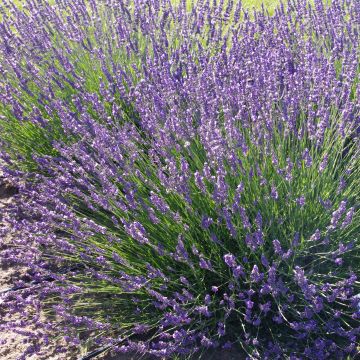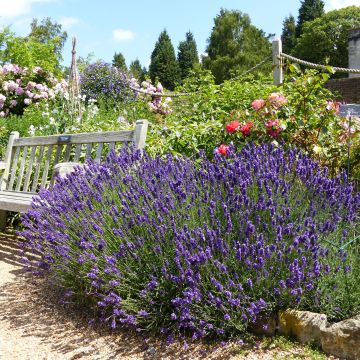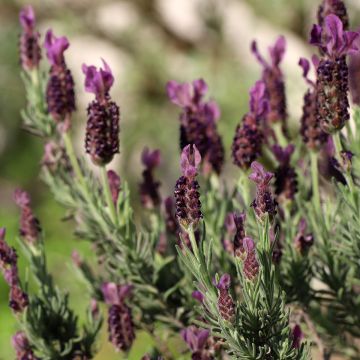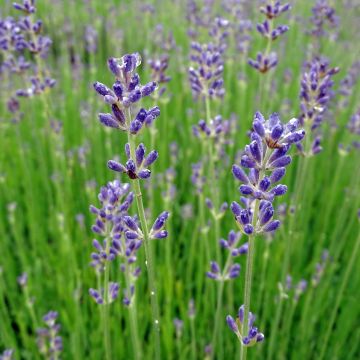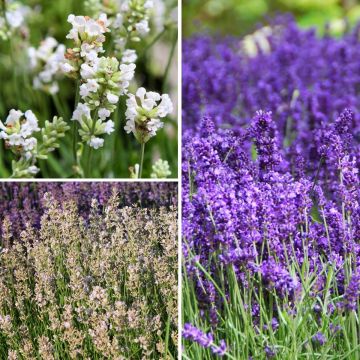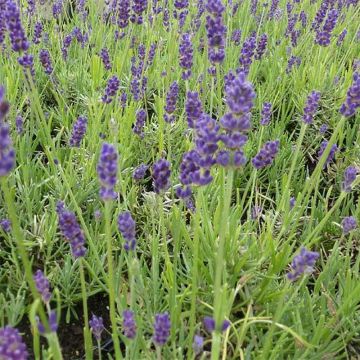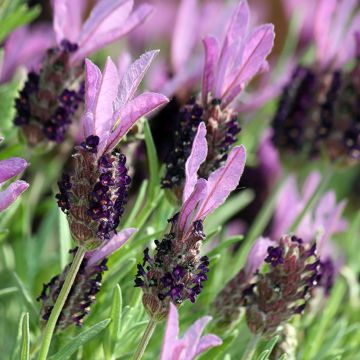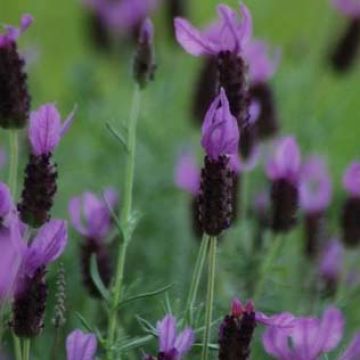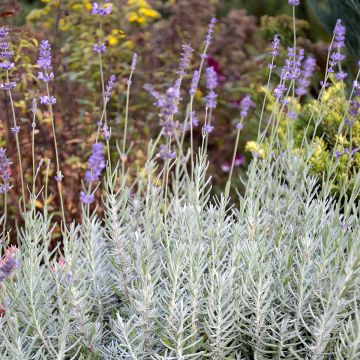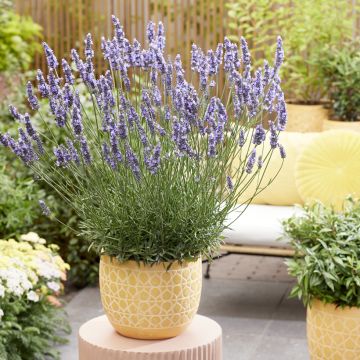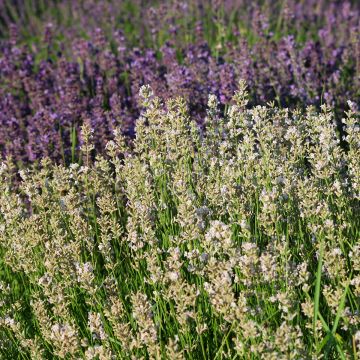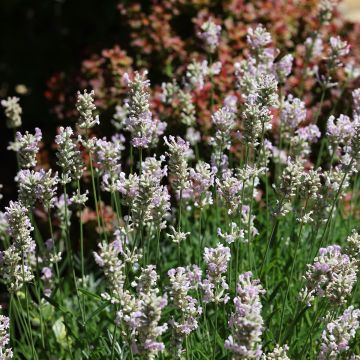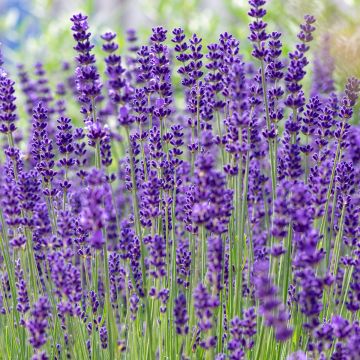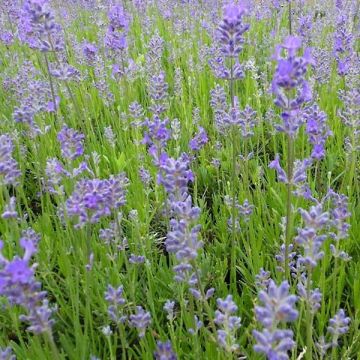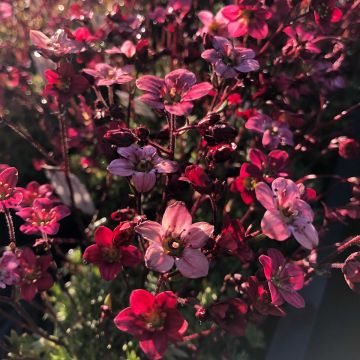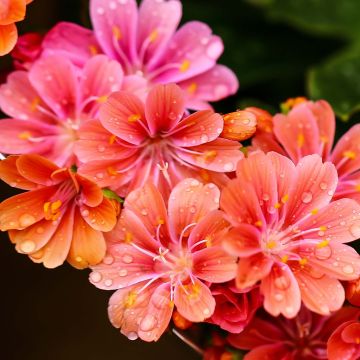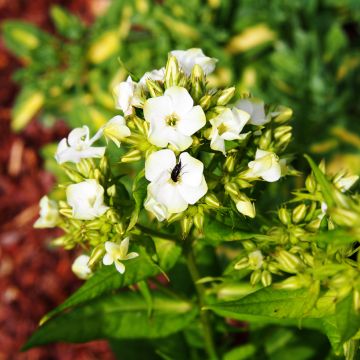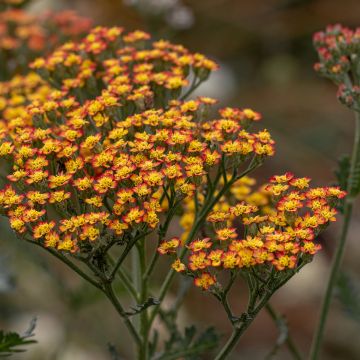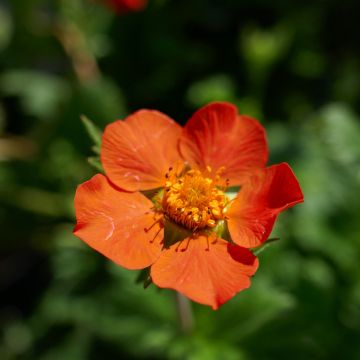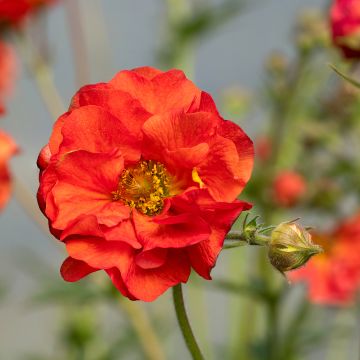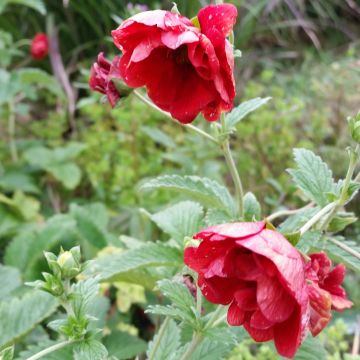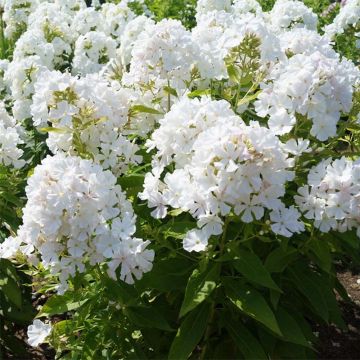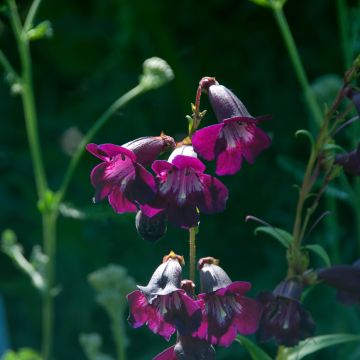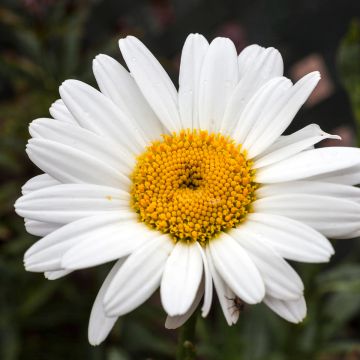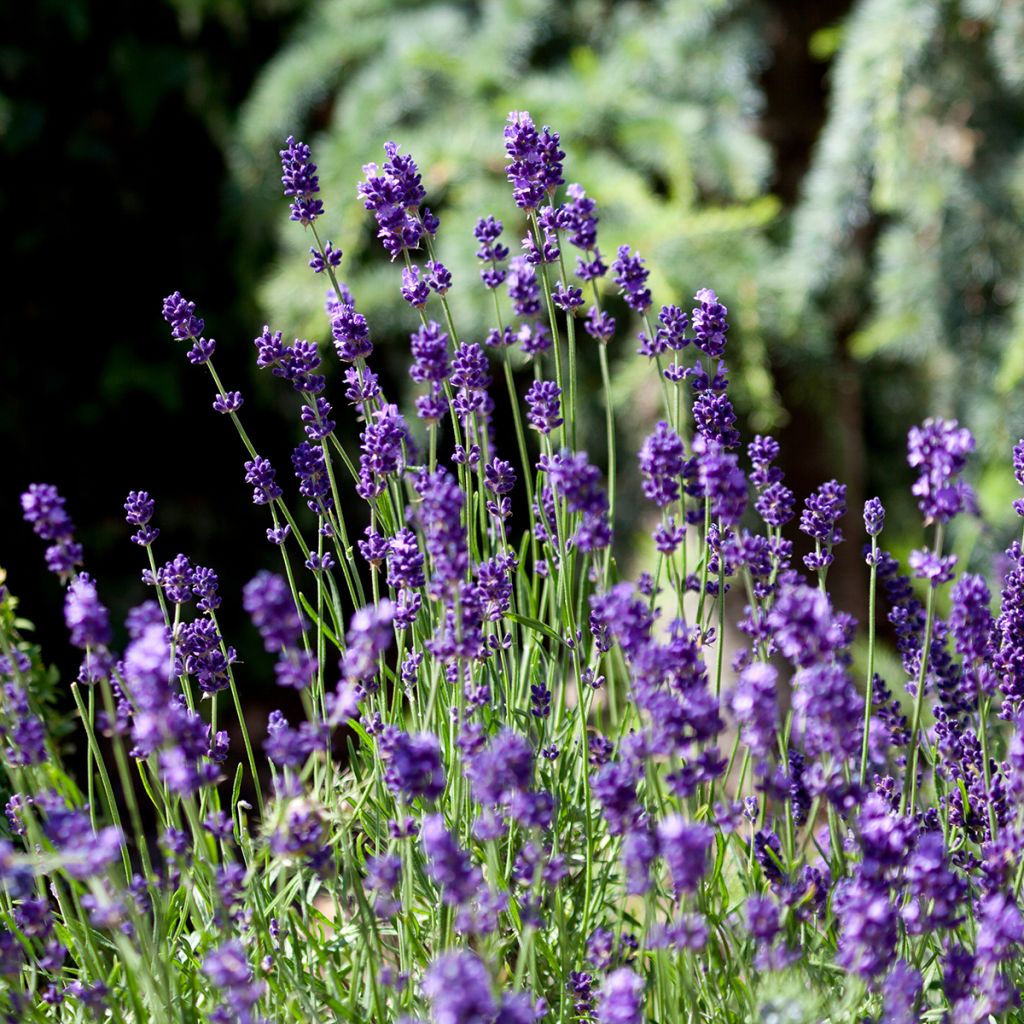

Lavandula angustifolia Montagnac Purple - True Lavender
Lavandula angustifolia Montagnac Purple - True Lavender
Lavandula angustifolia Montagnac Purple
True Lavender, English lavender
Why not try an alternative variety in stock?
View all →This plant carries a 12 months recovery warranty
More information
We guarantee the quality of our plants for a full growing cycle, and will replace at our expense any plant that fails to recover under normal climatic and planting conditions.
From €5.90 for pickup delivery and €6.90 for home delivery
Express home delivery from €8.90.
From €5.90 for pickup delivery and €6.90 for home delivery
Express home delivery from €8.90.
Delivery to Corse prohibited: UE law prohibits the import of this plant from mainland France to Corse as part of the fight against Xylella fastidiosa. Please accept our sincere apologies.
More information

Does this plant fit my garden?
Set up your Plantfit profile →
Description
Lavandula angustifolia 'Montagnac Purple' is a small variety, with spikes of fragrant purple flowers, whose flowering begins in June and ends in September. It is an low shrub with fine evergreen leaves that are highly aromatic and turn grey in the summer if the soil is dry. Planted in full sun, in well-drained soil, it is an ideal plant for borders, rockeries, and containers. Lavenders, are highly resistant to drought, are perfectly suited for ornamental use in Mediterranean gardens without irrigation.
Lavender 'Montagnac Purple' is a recent horticultural variety. The species, Lavandula angustifolia, is also known as English Lavender. It is a plant from the Lamiaceae family native to the Mediterranean basin, related to sage, thyme, and other rosemary plants. The 'Montagnac Purple' variety forms a small bush of 30-35 cm (12-14in) in flower, with a width of 35-40 cm (14-16in). Its decorative evergreen foliage is composed of small elongated aromatic leaves, measuring 4-5 cm (2in) in length, green in spring and becoming increasingly grey due to heat and drought. Its flowering, one of the earliest among lavenders, takes the form of a multitude of fragrant and melliferous flowers which are a deep purple colour, carried by cylindrical spikes measuring 5-6 cm (2in) in length, at the tips of slender woody and leafy stems. In reality, it is the coloured calyxes surrounding the flowers that influence the perception of the flower colour when viewed from a distance.
Lavender 'Montagnac Purple' grows in any well-drained, dry, poor, and rocky soil in full sun. In clay or excessively wet soil, it should be planted on a slope, in a raised bed, or in a rockery. This beautiful lavender can be used as a border plant alongside dwarf roses, dry soil grasses, and catmints, for example. It can also be planted in a rockery with thymes and oregano, or used to highlight a pathway... When cultivated in a pot, it should be regularly watered, but with spaced intervals to allow the substrate to dry between waterings.
Tips: Place dried flowers in a handkerchief and tie the four corners to perfume linen and repel moths. Create scented sugar by adding lavender leaves to brown sugar.
Properties: Lavender is a highly melliferous plant, contributing to the conservation of bees: the nectar from its flowers attracts bees, making some of the best honey.
Lavandula angustifolia is a medicinal plant, with once highly valued therapeutic properties: its essential oil has antiseptic, antispasmodic, healing, purifying, diuretic properties, among others...
Report an error about the product description
Flowering
Foliage
Plant habit
Botanical data
Lavandula
angustifolia
Montagnac Purple
Lamiaceae
True Lavender, English lavender
Cultivar or hybrid
Other Lavendula - Lavender
Planting and care
Lavender angustifolia 'Montagnac Purple' should be planted in spring in wet regions, and preferably in early autumn in dry and hot climates. Plant it with a spacing of 30-40 cm (12-16in) in a well-draining, dry, poor and stony soil in full sun. In clay soil or in excessively wet regions, mix compost, sand, and gravel with your garden soil and plant it in a mound so that water does not stagnate at root level. Don't forget to place gravel at the bottom of the planting hole for good drainage. Pruning is necessary after flowering to maintain a compact and floriferous habit. Once well-established in the ground, lavender requires no watering in summer (it can even harm it). Do not prune on old wood, as it may not regrow. After 10 years, the plant, with less flowering, should be replaced.
In a pot, watering should be regular, but allow the substrate to dry out between two waterings: a constantly warm and wet soil will cause the lavender to perish.
Planting period
Intended location
Care
-
, onOrder confirmed
Reply from on Promesse de fleurs
Summer flowering perennials
Haven't found what you were looking for?
Hardiness is the lowest winter temperature a plant can endure without suffering serious damage or even dying. However, hardiness is affected by location (a sheltered area, such as a patio), protection (winter cover) and soil type (hardiness is improved by well-drained soil).

Photo Sharing Terms & Conditions
In order to encourage gardeners to interact and share their experiences, Promesse de fleurs offers various media enabling content to be uploaded onto its Site - in particular via the ‘Photo sharing’ module.
The User agrees to refrain from:
- Posting any content that is illegal, prejudicial, insulting, racist, inciteful to hatred, revisionist, contrary to public decency, that infringes on privacy or on the privacy rights of third parties, in particular the publicity rights of persons and goods, intellectual property rights, or the right to privacy.
- Submitting content on behalf of a third party;
- Impersonate the identity of a third party and/or publish any personal information about a third party;
In general, the User undertakes to refrain from any unethical behaviour.
All Content (in particular text, comments, files, images, photos, videos, creative works, etc.), which may be subject to property or intellectual property rights, image or other private rights, shall remain the property of the User, subject to the limited rights granted by the terms of the licence granted by Promesse de fleurs as stated below. Users are at liberty to publish or not to publish such Content on the Site, notably via the ‘Photo Sharing’ facility, and accept that this Content shall be made public and freely accessible, notably on the Internet.
Users further acknowledge, undertake to have ,and guarantee that they hold all necessary rights and permissions to publish such material on the Site, in particular with regard to the legislation in force pertaining to any privacy, property, intellectual property, image, or contractual rights, or rights of any other nature. By publishing such Content on the Site, Users acknowledge accepting full liability as publishers of the Content within the meaning of the law, and grant Promesse de fleurs, free of charge, an inclusive, worldwide licence for the said Content for the entire duration of its publication, including all reproduction, representation, up/downloading, displaying, performing, transmission, and storage rights.
Users also grant permission for their name to be linked to the Content and accept that this link may not always be made available.
By engaging in posting material, Users consent to their Content becoming automatically accessible on the Internet, in particular on other sites and/or blogs and/or web pages of the Promesse de fleurs site, including in particular social pages and the Promesse de fleurs catalogue.
Users may secure the removal of entrusted content free of charge by issuing a simple request via our contact form.
The flowering period indicated on our website applies to countries and regions located in USDA zone 8 (France, the United Kingdom, Ireland, the Netherlands, etc.)
It will vary according to where you live:
- In zones 9 to 10 (Italy, Spain, Greece, etc.), flowering will occur about 2 to 4 weeks earlier.
- In zones 6 to 7 (Germany, Poland, Slovenia, and lower mountainous regions), flowering will be delayed by 2 to 3 weeks.
- In zone 5 (Central Europe, Scandinavia), blooming will be delayed by 3 to 5 weeks.
In temperate climates, pruning of spring-flowering shrubs (forsythia, spireas, etc.) should be done just after flowering.
Pruning of summer-flowering shrubs (Indian Lilac, Perovskia, etc.) can be done in winter or spring.
In cold regions as well as with frost-sensitive plants, avoid pruning too early when severe frosts may still occur.
The planting period indicated on our website applies to countries and regions located in USDA zone 8 (France, United Kingdom, Ireland, Netherlands).
It will vary according to where you live:
- In Mediterranean zones (Marseille, Madrid, Milan, etc.), autumn and winter are the best planting periods.
- In continental zones (Strasbourg, Munich, Vienna, etc.), delay planting by 2 to 3 weeks in spring and bring it forward by 2 to 4 weeks in autumn.
- In mountainous regions (the Alps, Pyrenees, Carpathians, etc.), it is best to plant in late spring (May-June) or late summer (August-September).
The harvesting period indicated on our website applies to countries and regions in USDA zone 8 (France, England, Ireland, the Netherlands).
In colder areas (Scandinavia, Poland, Austria...) fruit and vegetable harvests are likely to be delayed by 3-4 weeks.
In warmer areas (Italy, Spain, Greece, etc.), harvesting will probably take place earlier, depending on weather conditions.
The sowing periods indicated on our website apply to countries and regions within USDA Zone 8 (France, UK, Ireland, Netherlands).
In colder areas (Scandinavia, Poland, Austria...), delay any outdoor sowing by 3-4 weeks, or sow under glass.
In warmer climes (Italy, Spain, Greece, etc.), bring outdoor sowing forward by a few weeks.

































